A weekend at Louisiana’s oldest harvest festival.
I am traveling south on Highway 1 through Iberville Parish, Louisiana. I pass fields of sugarcane, chemical factories, strange roadside cemeteries, and what appears to be a combination seafood restaurant and barbershop ambiguously advertising “‘Phresh Cuts.”’ It is Friday afternoon, the start of Labor Day weekend. It is a manageable 87 degrees outside, for now.
On the radio, reporters are discussing the devastation caused by Hurricane Harvey in Houston. Some are suggesting the damage was exacerbated by rampant construction, all the developers’ paving over of marshes that used to absorb rainwater. Louisiana has been largely spared, this time.
I am thinking about some of these things—oil, energy dependence, supply chains, weather systems, development, inescapable death and destruction—or trying to anyway. There is another part of me that is preparing to consume something close to my own body weight in shrimp.
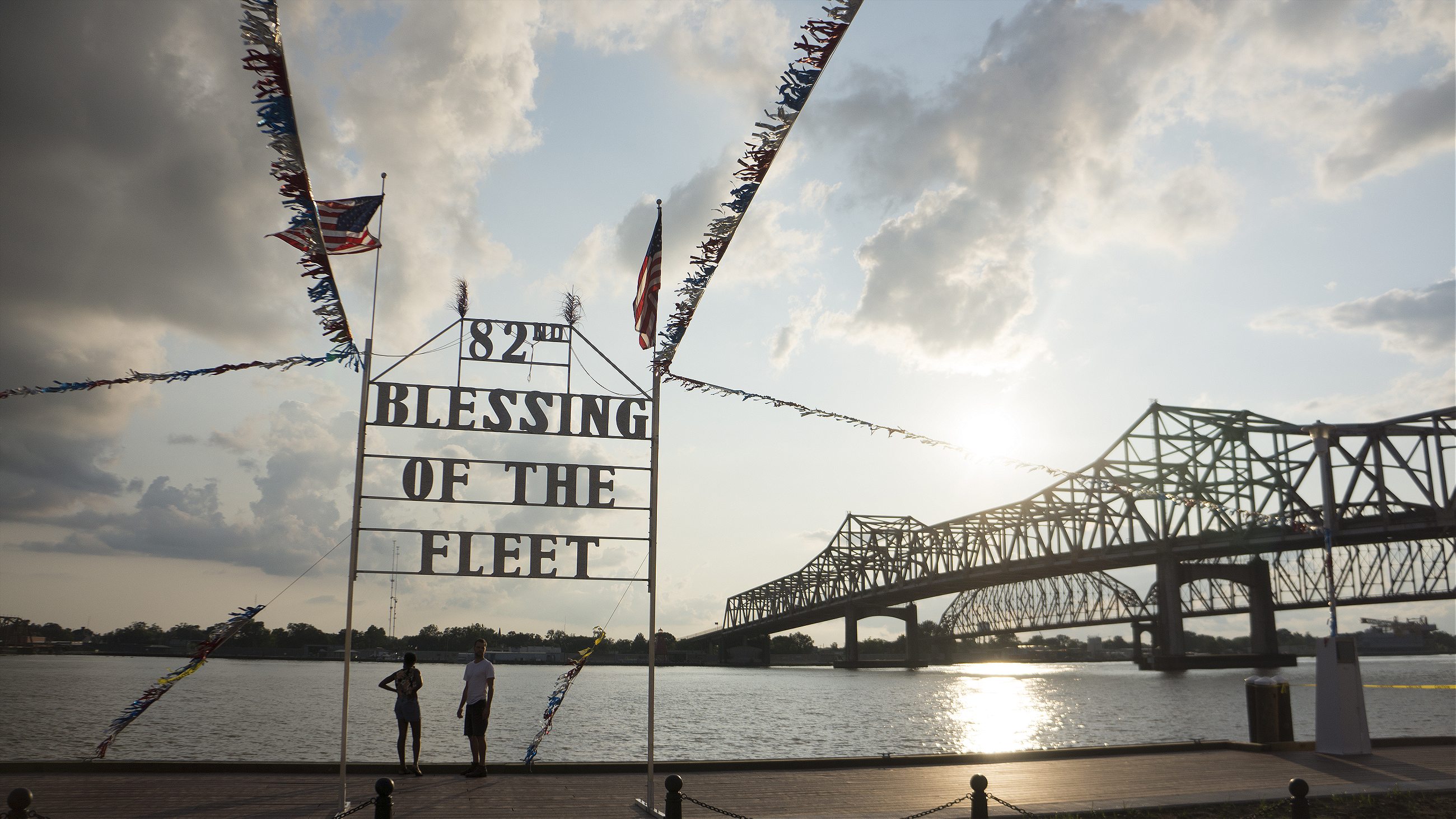
I’m headed to the annual Shrimp and Petroleum Festival in Morgan City. The festival is the oldest state-chartered harvest festival in Louisiana. It began in 1936 as a single day, when all the shrimp boats in Morgan City would line up in the Atchafalaya River to be blessed by a Catholic priest.
In the 1960s, as oil became the dominant industry in town, petroleum was added to the name and the logo became a shrimp in a hard hat wrapped around an oil derrick.
It is the first day of the festival and things are still being set up. The lemonade stand is enticing, but unmanned. The music stage on the southwest corner of Lawrence Park is unoccupied. I am here, along with two equally curious friends. We decide to go see Mr. Charlie.
Mr. Charlie is an aging offshore drilling rig that has been turned into a museum. Shore bound on the banks of the Atchafalaya River, it was the first transportable and self-sufficient drill rig, and operated between 1954 and 1986. It sits on a 19,000 square foot barge with the drilling platform 60 feet above. We are led onto the barge and up multiple flights of steel stairs to the drilling floor, where our tour guide is waiting. He is wearing a blue mechanic’s jumpsuit and seems to be in a state of continuous perspiration. He is a man that likes drilling.

He gives us a rundown of the drilling operation on the Mr. Charlie when it was in service. He outlines the development of new technologies, air-conditioned control rooms, and enhanced safety features that now prevent workers from losing fingers to the configuration of chains and massive pipe wrenches used to attach the joints of drill pipe. He seemed to lament the loss of loss of digits.
Since the oil began flowing in Louisiana in 1901, the industry has had an intimate relationship with the state. In 1960, A.J. Liebling wrote, “Oil gets into politics, and politicians, making money in office, get into oil. The state slithers around in it.” It has meant a Louisiana Department of Natural Resources that has permitted the oil industry to do whatever it likes in the Gulf of Mexico. What it likes, is to dredge canals and lay pipelines to facilitate the extraction of oil.
Those pipelines and canals let saltwater enter into the freshwater marsh areas, which eventually leads to their erosion. “Pipelines and canals ate the coastal zone like PAC-MAN,” professor Oliver Houck of Tulane University Law School wrote in a journal article a few years ago. As a result, Louisiana loses a football field of coast an hour.
But even as oil companies were becoming aware of the damage they were causing, dredging continued. Efforts to mitigate the damage or force oil companies to repair the harm they had already done were met with fierce opposition by the state legislators, officials, governors, and the industry itself. One state representative referred to this cooperation between the state and industry as a “kind of gentlemen’s agreement.” The Department of Natural Resources even developed a $10,000 campaign that would take out-of-town reporters on fishing trips if they agreed to write stories that demonstrated the harmonious relationship between the oil industry and recreational fishing.
The Deepwater Horizon spill, in 2010, pumped more than 200 million gallons of crude oil into the Gulf of Mexico. But if the pictures of oil drenched seagulls were the most visible and startling representation of the environmental impacts of offshore drilling in the gulf to date, the spill in some ways was only a punctuation mark on the longer history of oil companies, with the assistance of the state, forgoing environmental concerns in favor of immediate profits.
But today, the oil industry is in a slump. Prices per barrel are down, and according to our tour guide, the offshore rigs are losing money. “You got hundreds of thousands of people out of work, and billions of dollars of equipment sitting idle, globally,” he explains. In Morgan City, the decline is palpable. Businesses dependent on the offshore industry are struggling for survival. The Red Roof Inn, which is a sprawling complex large enough to house a small nation’s armed forces, is eerily vacant. Louisiana Highway 182, the thoroughfare on which it is located, has very little traffic and feels absurdly wide.
For a shrimp festival, there seems to be very little emphasis on shrimp.
Back at the festival, we decide to check out the Cajun Culinary Classic, which sounds like a cooking competition, but is not. Nor is it excessively Cajun. It is a row of food stands. A few of the stands are serving jambalaya, one has crawfish pies, but most have things like burgers and fries, and fried foods on a stick. There is a stand just called “‘Asian Food.’” For a shrimp festival, there seems to be very little emphasis on shrimp. You can get a fried shrimp basket, or a skewer of grilled shrimp, but this puts the Cajun Culinary Classic in the company of approximately every other dining establishment in the state of Louisiana.
There is another, larger cluster of food stands under the Highway 90 overpass. These, too, fail to be the celebration of shrimp that we had been hoping for. Distressingly, the food I see being consumed most often during the festival is not shrimp at all, but blooming onions.
By this time it is oppressively hot. There is something about standing under a large concrete overpass in swampy heat surrounded by deep fryers that makes you feel limp and absorbent, like a french fry in first blanch. We try some fried bacon-wrapped shrimp. They aren’t bad. We stand around trying to articulate what the festival is missing in culinary spirit. A companion reveals he had been hoping for a shrimp geyser. Maybe, it will occur to me days later, we had unreasonable expectations.
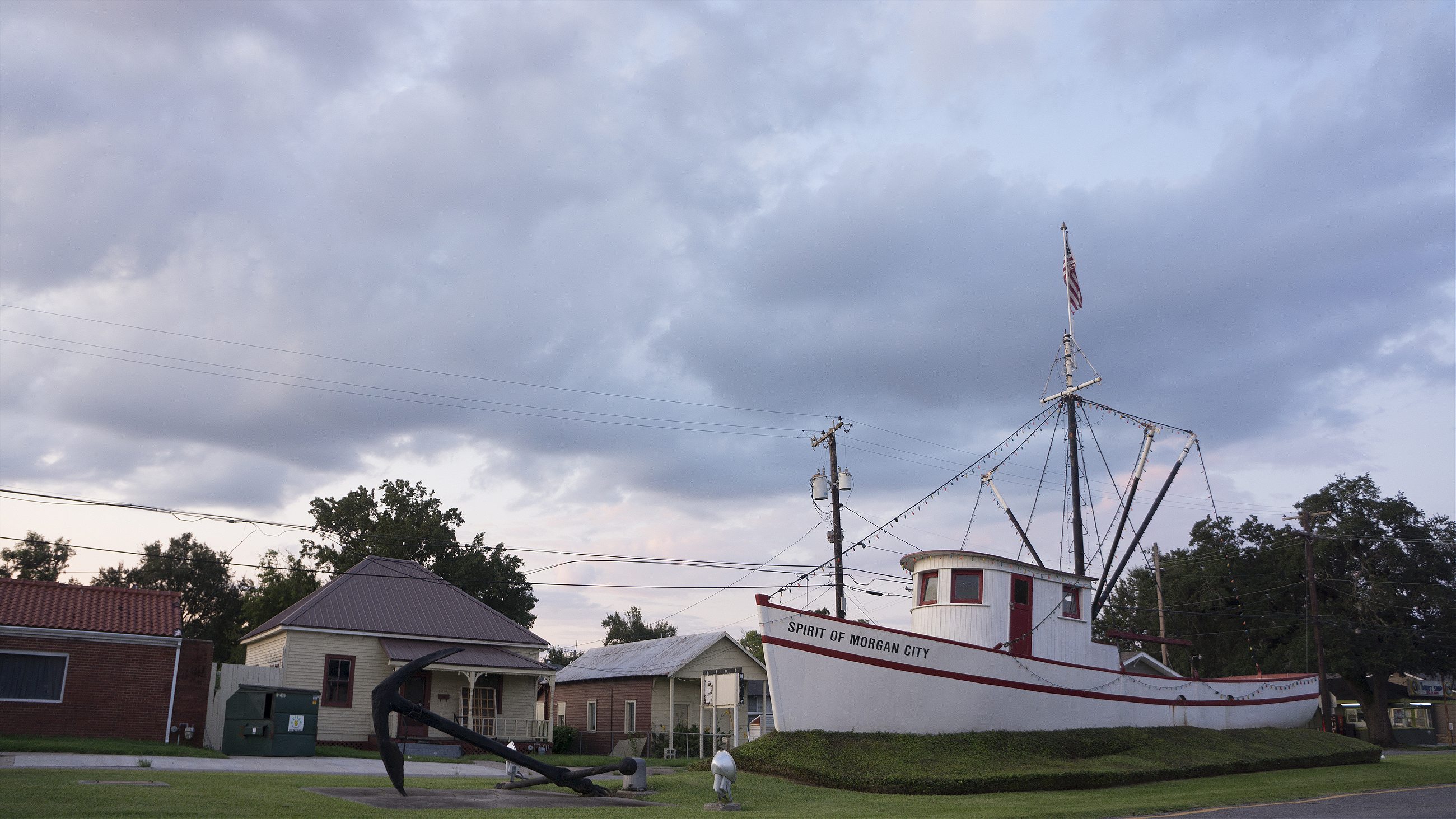
Throughout the weekend I will come to learn that the shrimp industry, too, is not what it once was in Morgan City. Shrimp boats that used to line the dock five deep have become a rarity, replaced with houseboats and pleasure craft.
On recommendation of our tour guide, we head to Rita Mae’s Kitchen, just a few blocks from the overpass. Things are better here. The interior is a pleasing combination of deep turquoise and magenta. On the wall is a poster of Malcolm X shooting pool with Martin Luther King Jr. and Nelson Mandela.
We have the crab-stuffed bell pepper, shrimp etouffee over rice, braised cabbage with ham hocks, fried catfish, fried shrimp, and two pieces of corn bread. Not a shrimp geyser, but satisfying. Like every good meal, it is both stimulating and sedative and allows us to forget the disappointments of the recent past.
I had thought the festival would be just another way for the oil industry to advertise its harmonious relationship with nature and the seafood industry, but in fact, the festival seems to have very little discernible message. There is a crafts fair. There is a carnival run by Mitchell Bros. and Sons Amusements. There are games where you can win live iguanas and pot-bellied pigs. (I had never heard of such a prize before, but apparently in Louisiana it is standard.)
Aside from the name, the logo, and a cocktail called PetroPunch (which is made with something called Rougaroux rum and which I do not try) there is little at the festival that is actively promoting the petroleum industry. The festival has gone from a shrimp festival, to a shrimp and petroleum festival, and now it appears to be just a festival.
“Originally we were an agrarian society,” Nelson B. Cortez, Festival King of ’02, says in a back office of the festival welcome center. “When an area would bring in the principle crop, after the crop was brought in and harvested, they would have a big get-together. And it eventually became a festival. Well, down here we just made a business out of it. We just have them all over.”
A look at the calendar of the Louisiana Associations of Fairs and Festivals confirms it. There is the Breaux Bridge Crawfish Festival, the Buras Oilfield Crawfish Boil-Off, Crawfish Cookoff in Slidell, Crawfish Jams in New Roads, Louisiana Crawfish Festival in Chalmette. The Corn Festival, the Cotton Festival, the Peach Festival, the Pecan Festival. Three catfish festivals. Cooterfest. The Louisiana Gumbo Festival of Chackbay. The Iowa Rabbit Festival (in Iowa, Louisiana). The Giant Omelette Celebration. Delcambre Shrimp Festival, Etouffee Festival, Cochon de Lait Festival. Parks Crackling Cook-off. Natchitoches Meat Pie Festival. The Fur and Wildlife Festival.
“There’s gonna be music, and there’s gonna be food, and there’s gonna be crafters,” Cortez explains. “And there’s gonna be rhinestone sisters walking around,” he says, referring to the Festival Queens.
Each year a college freshman is chosen by the festival’s board of directors to be the Festival Queen. The Festival King, who for the past two years has been a middle-aged man with some connection to the oil- industry, is chosen by the ‘Past Kings Club.’ Cortez tells me that in the past, the Festival King was the captain of the shrimp boat with the greatest yield that year.
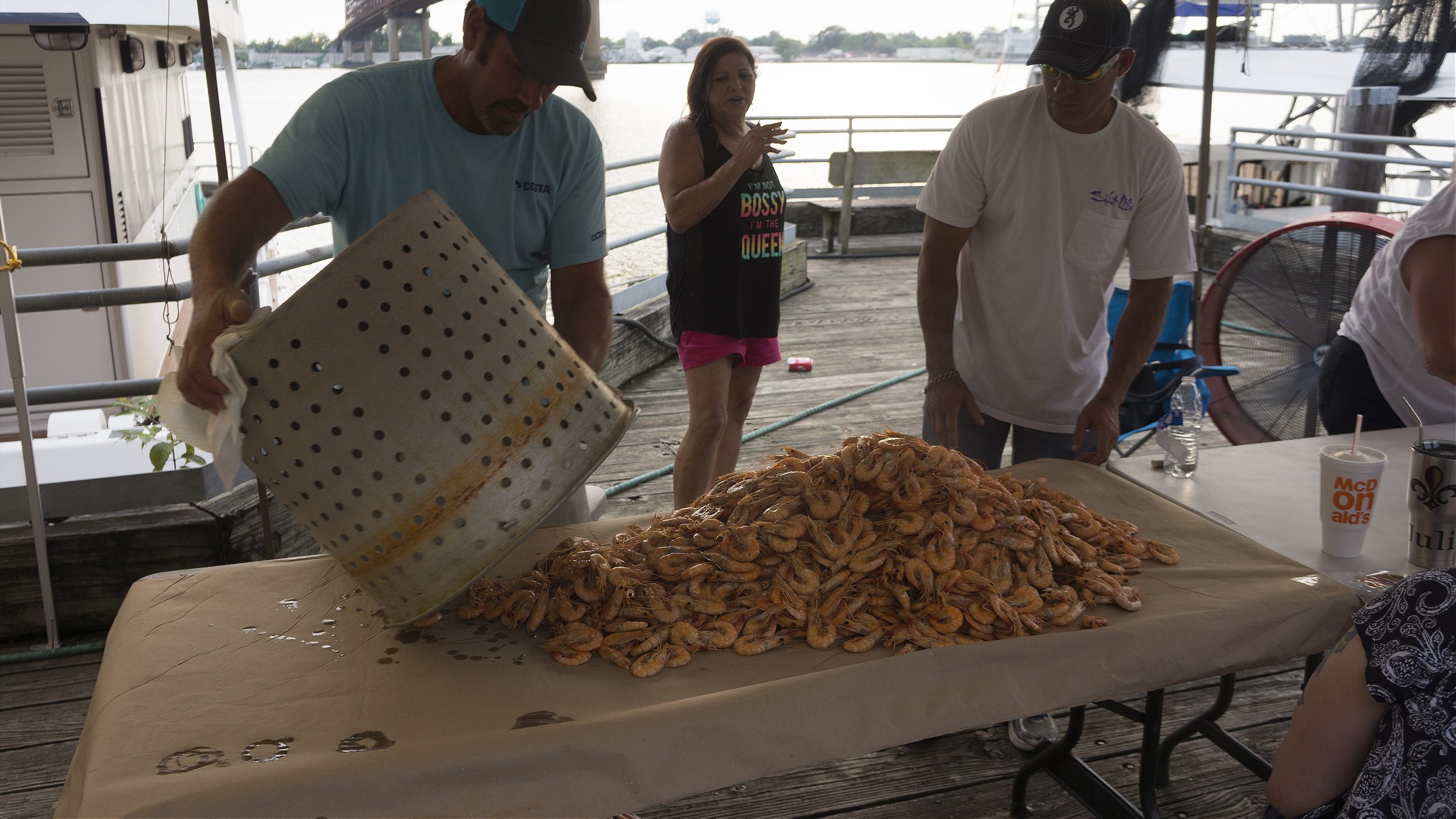
After the festival, the King’s obligations are finished. The Festival Queen is either invited or contractually obligated to attend a certain number of other festivals throughout the state, so at any given festival you have a whole coterie of Queens wandering the grounds in their crowns and identifying sashes. I personally observe the Plaquemines Orange Queen, Queen Sugar, Crawfish Queen, and the International Rice Queen, among others.
Without the shrimp industry in Morgan City, it feels like the festival has lost a bit of its soul. I ask Rodney Grow, festival vice-president (head of the fireworks committee, King of ’88), what it is he loves about the festival. “The fireworks,” he says, honestly. But he then seems to catch himself. “The blessing is where it all started, and that’s where we should concentrate more.”
The 82nd annual Shrimp and Petroleum Festival Mass was supposed to be celebrated in Lawrence Park, but due to fears of inclement weather, it had been moved to Holy Cross Church. When I get there, it is the middle of the sermon. The place is mostly full.
In front of the altar there is a table that has the royal crowns. On the left of the crowns is a chalice filled with shrimp. I can’t get close enough to see if these shrimp are fresh, cooked, or fake. To the right of the crowns is a small glass pitcher, filled with a murky orange liquid—petroleum, presumably.
On the floor in front of the table are two model oil derricks, painted gold. Hanging from them are strings of plastic beads with plastic shrimp and a medallion displaying another oil derrick, spouting oil. I can’t stay at Mass long, and as I leave, the Jambalaya Queen is receiving communion. I have to go meet Kermit Duck for the Blessing of the Fleet.
Kermit Duck, in his mid-40s, has a perpetual grimace that reminds me of Clint Eastwood. He has been shrimping his whole life, first with his grandfather, and independently since he was 24. He guesses he is one of four or five shrimpers left in Morgan City who do it for a living. I met Kermit the night before on the dock. He had just brought his boat in from being out five nights on the gulf. He didn’t feel like talking, but I persuaded him to let me ride along with him on his boat during the blessing.
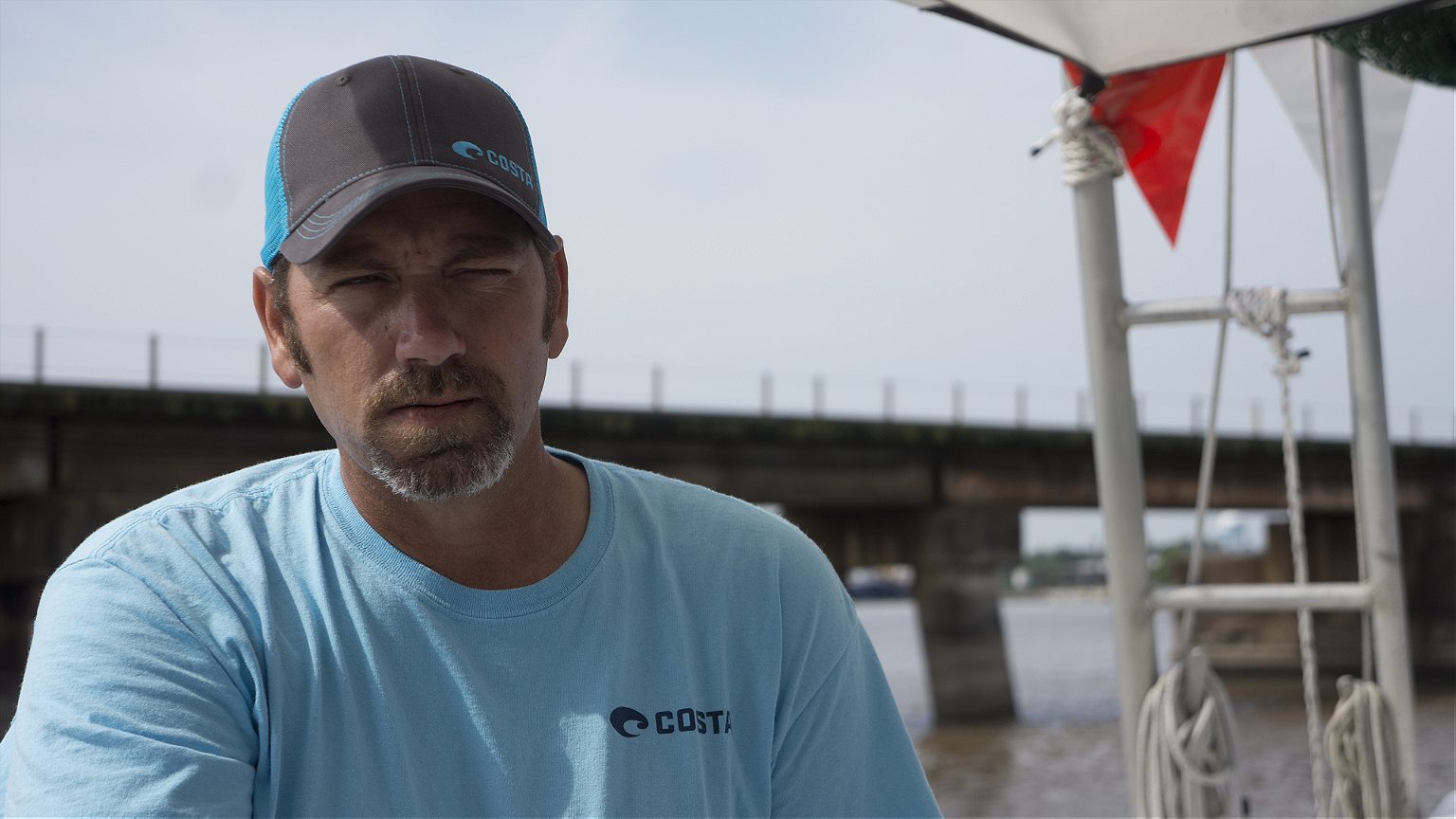
The blessing consists of boats circling around in the Atchafalaya River and eventually passing by the dock where the priest is waiting to bless each one with holy water. I chat with Kermit while his son, who is around 10 or 11, steers the boat. Some years ago, when he was maybe 5 years old, Kermit’s son wanted to be a shrimper. Now he is leaning towards game warden.
Business is tough for Kermit, and his grievances are many. There are municipal decisions that favored the oil industry and pushed shrimpers out of Morgan City; convoluted federal regulations that are more burdensome to independent fisherman than larger operations; environmental organizations claiming shrimpers are killing turtles when, in fact, according to Kermit, they are not; cheap foreign imports that are driving down shrimp prices at the processing plants; and the BP oil spill, from which he says his catch still has not recovered.
This year just two shrimp boats, including Kermit’s, are taking part in the blessing. Kermit describes past festivals in which the blessing involved many more shrimpers. Afterward each one of them would boil a big pot of shrimp on the pier for anyone who wanted some. It didn’t matter if you were from New York, Kermit says, you could come up and get your shrimp. I realize that this was the type of thing I had been looking for in a shrimp festival. Shrimpers, boiling their shrimp, for the people.
As the boat approaches the waiting priest, I ask Kermit if he isn’t resentful of the oil industry for pushing out shrimpers. “Sure. I am,” he says. “But that’s how things go. They call this the land of the free, but someone is always getting pushed out of something.”
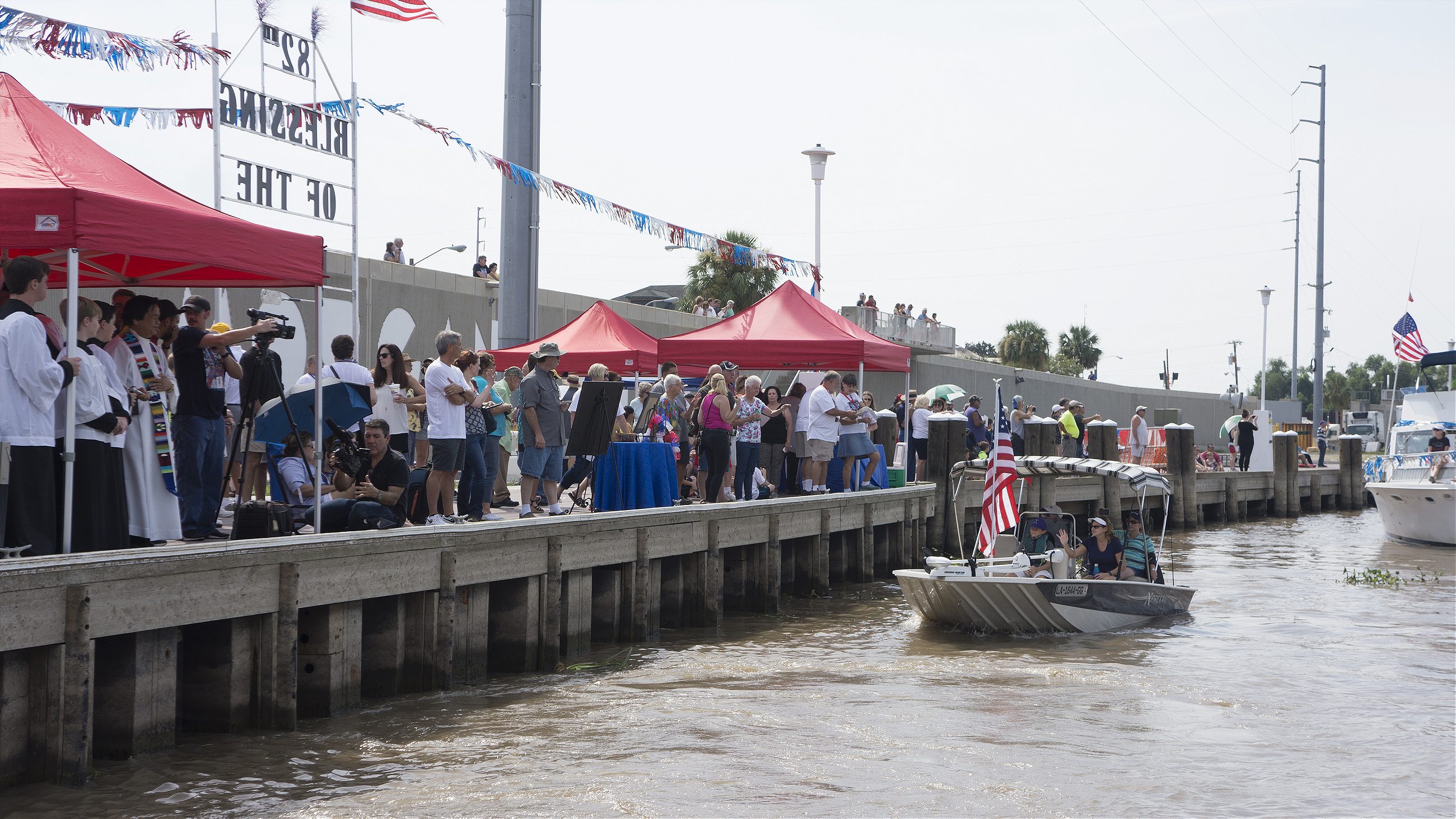
I don’t hear it, but apparently on the radio, it is announced that Kermit’s boat has received second place in the boat decoration contest. First place, which comes with a cash prize, has apparently gone to a boat that is not an active shrimper. “It’s rigged,” says Kermit. We float around in the river for a while, and eventually head back to shore. Kermit invites me to come by the dock later, where he will be boiling a pot of shrimp.
Later that day, Kermit dumps the pot out onto the table, and we eat the shrimp and potatoes and corn and mushrooms, along with an unimpeachable dip, which they call dip, that seems to consist primarily of mayonnaise and ketchup mixed together. A young girl who is eating shrimp across the table from me is warned not to triple-dip in the communal bowl of dip and is then offered her own individual bowl of dip, so that she can triple-dip. After she receives her bowl, she dips a shrimp in the dip, and before taking a bite, she looks me right in the eyes and says: “I always triple-dip.”
The shrimp is delicious and I eat a lot of it. In some sense, I have gotten what I came for. But still, as I throw my pile of shrimp heads and shells back into the water, I am overcome by a sense of loss and resignation. The sun is beginning to set behind the Long-Allen Bridge over the Atchafalaya River. I leave before the fireworks.
